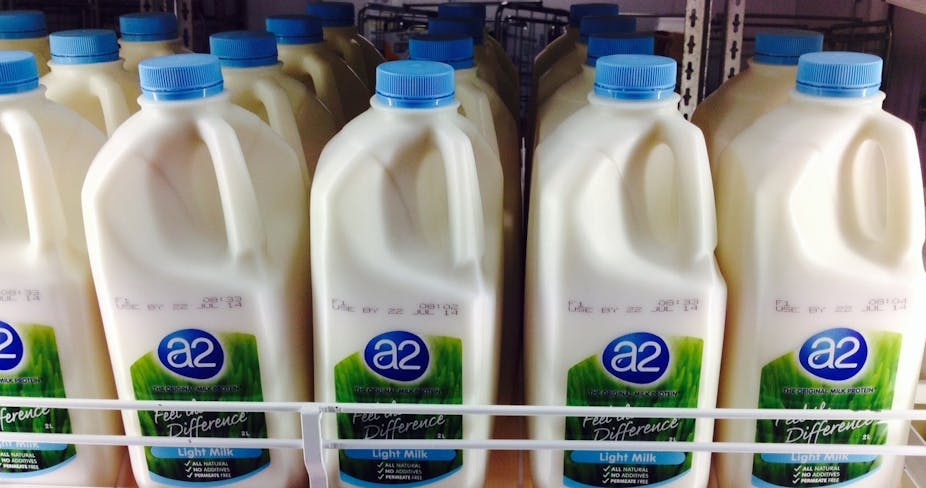The new big thing hitting our supermarket shelves is “A2 milk”. Not only has this resulted in a great debate about whether it is any better for us than regular cow’s milk, but also a bitter feud over labelling between the big dairy companies in the Federal Court.
So what is A2?
Cow’s milk contains protein. The primary group of milk proteins are the caseins. A1 and A2 are the two primary types of beta-casein (beta-casein is one of the three major casein proteins) present in milk. They are simply genetic variants of one another that differ in structure by one amino acid.
The A1 protein produces beta-casomorphin-7 (BCM-7), which has been shown to alter gastrointestinal function (slowing down bowel movements from stomach to anus) and increase inflammation in the gut in animal studies.
Commonly, both A1 and A2 types of casein are expressed in cow’s milk in Europe, America, Australia and New Zealand, and hence the milk we find on our supermarket shelves.
The hype surrounding A2 milk came about after the patenting of a genetic test by the a2 Milk Company. The patent allows the company to determine what type of protein a cow produces in its milk and therefore license dairy farmers that prove their cows express only A2 protein in their milk (and not A1 protein). A2 milk is marketed by the a2 Milk Company to contain only the A2 type of beta-casein.
Initially, there were marketing claims that A1 proteins were harmful to our health, but a full review of the literature by the European Food Safety Authority (EFSA) in 2009 nullified such claims. Insufficient evidence exists to suggest A1 proteins have a negative effect on our health. The EFSA found no relationship between drinking milk with the A1 protein and non-communicable diseases such as type 1 diabetes, heart disease and autism, which is the focus of much of the hype.
After these findings were released to the public, the marketing focus shifted towards the A1 protein causing digestive discomfort and symptoms usually associated with lactose intolerance (for example, bloating and flatulence).
The first peer-reviewed human study was conducted with a small number of people (41). Only ten of the participants reported an intolerance to commercial cow’s milk. They compared differences after drinking milk containing only the A1 protein versus milk containing only the A2 protein (the milk on our supermarket shelves is usually a combination of the A1 and A2 milk proteins).
Interestingly, they found after drinking the milk containing A1 protein only, participants reported softer stools than when drinking the A2 milk. These results tend to go against the evidence in animal studies that the A1 protein slows down the movement of contents through the gastrointestinal system, which could be thought to bulk up stool content and hence result in harder stools.
The authors of this study suggested the softer stools might have been caused by an increase in gut inflammation caused by consumption of the A1 protein. Gut inflammation can cause malabsorption of fluids and nutrients and hence softer stools. However, the study found no difference in calprotectin (a measure of inflammation) between the two milk groups, so it failed to draw any sound conclusions.
This led to the second study conducted in humans, which was published this year. Unlike the previous study, it did use common commercial milk that contains both the A1 and A2 milk proteins and compared this to consuming milk containing only the A2 protein. It included only people (45 subjects) who self-reported an intolerance to cow’s milk.
Of the 45 subjects, 23 were diagnosed as lactose-intolerant. Someone who is intolerant to cow’s milk has an inability to digest lactose due to a deficiency in the lactase enzyme. But it is important to note lactose is present in both A1 milk and A2 milk.
The results showed A2 milk did not cause an increase in unpleasant digestive symptoms (for example, bloating and flatulence) usually associated with milk consumption in those who are lactose-intolerant. When cow’s milk containing both the A1 and A2 proteins was provided, there was an exacerbation of stomach upset. However, this would be expected for someone who is sensitive to dairy products, or lactose-intolerant.
The changes in inflammatory markers observed in this study need to be interpreted carefully. Despite some statistically significant changes between the two milk groups being noted, these aren’t necessarily clinically relevant and therefore do need further investigation in a much larger study with a greater sample size.
So is A2 worth it?
For those who do not experience any problems with milk consumption, there is no evidence to suggest any benefit in having A2 milk over the common consumed commercial milk, which contains both the A1 and A2 proteins. For less than half the price per litre, the latter would be the favoured option.
For those who self-report an intolerance to milk or are lactose-intolerant, A2 milk may be a suitable selection to prevent commonly reported stomach upset complaints, but so too is lactose-free milk. Lactose-free milk does not contain lactose, which is the naturally occurring sugar that causes the gastrointestinal problems in the lactose-intolerant. Consequently, what is needed is a study comparing the effects of lactose-free milk versus A2 milk in those who are lactose-intolerant.
Most importantly, longer-term studies with larger sample sizes are needed, as both of the studies conducted in humans to date have been conducted with small numbers over short durations.
The most important thing is that we don’t exclude milk products from the diet, as dairy is a rich source of calcium that is readily bio-available (meaning we can absorb the majority of it from this food source). Calcium is essential for the prevention of osteoporosis (brittle or weak bones) and an adult should aim for three dairy serves per day.

